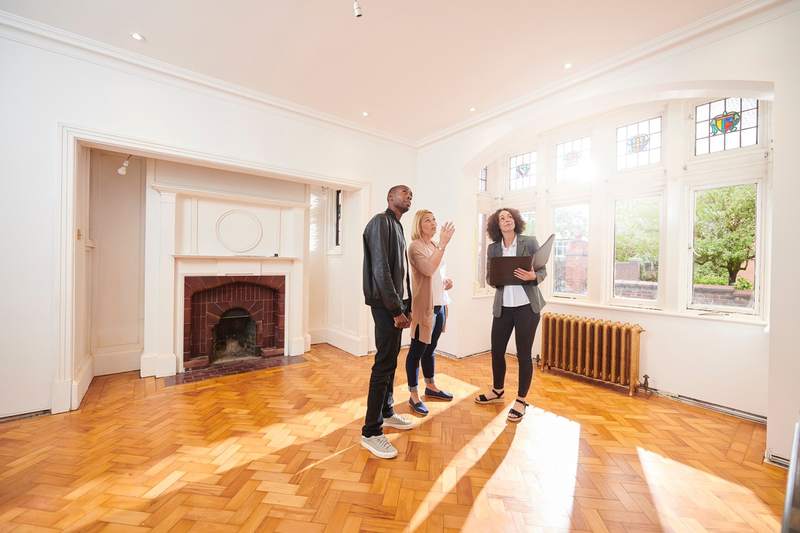Buying a house can seem like an unattainable goal. Prices rise more quickly than incomes, and it can feel like you need perfect credit and thousands of dollars saved up for closing costs and a down payment to have even a chance of buying a home.
But the complicated reality of buying a house can differ from what people new to the process expect going in, as shown by these surprising real estate facts.
1. You Don’t Have To Pay Closing Costs Upfront
Closing costs are a big financial barrier to buying a home. These costs include home appraisal fees, title insurance, prepaid property taxes, and homeowners insurance, and usually come to 2% to 5% of the purchase price. However, many lenders offer no-closing-cost mortgages that wrap those fees into the loan balance, usually in exchange for a higher interest rate. This will save you money upfront but will increase your total loan costs.
2. You Don’t Need a 20% Down Payment
While a 20% down payment is nice to have — and lets you avoid the extra expense of private mortgage insurance — it’s not required. Conventional loans — the most common mortgage type — require only 3% down for a fixed-rate mortgage and 5% down for an adjustable-rate mortgage. Home loans backed by the Federal Housing Administration require a minimum down payment of 3.5%, while Veterans Affairs loans and U.S. Department of Agriculture loans have no minimum down payment requirement.
“Not only do FHA and VA loans allow you to purchase a home for much less money down, but the interest rates associated with them are usually significantly lower than conventional mortgages,” says Jordan Fulmer, owner of Momentum Property Solutions, a Huntsville, Alabama-based real estate company.
3. First-Time Homebuyers’ Average Down Payment Is 6%
First-time buyers make an average down payment of 6% of the purchase price, according to the National Association of Realtors. Note that with conventional loans, a down payment of less than 20% will require you to pay for PMI.
4. Repeat Homebuyers’ Average Down Payment Is 17%
The average down payment for repeat homebuyers is 17%, according to NAR.
5. 47% of Buyers Used Their Savings for the Down Payment
Of all homebuyers, 47% used their savings to make the down payment on their home purchase in 2022.
6. 22% of First-Time Buyers Used Gift Money for the Down Payment
NAR also found that 22% of first-time homebuyers used a cash gift from family or friends to help make their down payment.
7. 7% of All Buyers Used Gift Money for the Down Payment
It isn’t just first-time homebuyers relying on gift money for a down payment. Another NAR study found that 7% of all homebuyers used a cash gift for their down payment.
8. First-Time Homebuyers Are 32% of Buyers
First-time homebuyers made up 32% of new home purchases in 2023, up from 26% the year before. The average since 1981 is 38%.
9. The Typical First-Time Homebuyer Is 35 Years Old
When it comes to buying their first home, NAR statistics peg the average buyer’s age at 35, down slightly from last year’s record high of 36.
10. The Typical Repeat Homebuyer Is 58 Years Old
While the average age of a repeat homebuyer was 59 in 2022 — a record high for NAR data — it fell to 58 in 2023.
11. Most Homebuyers Are Millennials
One of the fun facts about recent homebuyers is that a combined 43% of them are millennials, with 25% born between 1980 and 1989 and 18% born between 1990 and 1998.
12. Married Couples Are 59% of Homebuyers
The majority of recent homebuyers are married couples, coming in at 59%, according to NAR. Among the remaining buyers, 10% were unmarried couples.
13. Less Than One-Third of All Homebuyers Are Parents
Of all buyers surveyed by NAR, 30% report they have children under age 18 living with them, down from 58% in 1985.
14. 29% of Buyers Are Single
Single women represent 19% of recent home purchases while single men made 10% of such purchases.
15. 16% of Recent Homebuyers Are Veterans
VA loans can make buying a home more accessible for active-duty military service members, veterans, and their families. Among recent home purchases, 16% were bought by veterans and 2% were bought by active-duty service members.
16. 42-to-56-Year-Old Homebuyers Have the Highest Household Income
Buyers in Generation X — currently ages 42 to 56 — have the highest income of recent homebuyers. In 2020, the last year this data was collected, Gen X buyers had a median income of $125,000.
17. You Can Buy a Home Without Perfect Credit
The average credit score in the U.S. is 718. That means most people meet the minimum credit score requirement for one of these common types of mortgages:
- Conforming conventional loans typically require a credit score of at least 620.
- Nonconforming conventional mortgages — aka jumbo loans — have no set minimum credit score. However, since these loans are for large amounts, lenders will set their own standards and usually want to see a credit score of 680 or higher.
- FHA loans have a minimum credit score requirement of 500 with a down payment of at least 10%, or 580 with 3% down.
18. You Can Buy a Home If You Have No Credit
If you have no credit, it’s still possible to get a mortgage and buy a home, but it will be more difficult.
One way to qualify without credit is to find a mortgage lender that uses manual underwriting. That means a human, not a computer program, evaluates your application. You’ll need to show that you can handle the monthly payment by providing employment documentation, prove that you’ve paid other bills — especially rent — on time, and document assets such as savings accounts and investments. If you need this type of underwriting, look first to smaller lenders like credit unions and local banks.
19. You Can Buy a Home If You Have Student Loan Debt
Even if you have student loan debt, you still can get a mortgage. Lenders don’t treat student loan debt differently from other types of debt. If your student loans don’t push your debt-to-income ratio above the maximum for your loan type or lender, those debts won’t disqualify you from mortgage approval.
20. About Two-Thirds of Americans Own Their Home
The U.S. homeownership rate was 66% in the third quarter of 2023. That’s lower than the peak of 69% in 2004, but roughly in line with the average homeownership rate since 1986.
21. Most Homebuyers Use a Real Estate Agent
There’s no hiding that buying a home is complicated. That’s why 89% of homebuyers used a real estate agent.
22. 71% of Homebuyers Only Interview One Agent
When looking for the best real estate agent for their needs, homebuyers tend to stick with the first person they interview. NAR found that 71% of homebuyers only interviewed one agent before moving forward with their home purchase.
23. 90% of Buyers Would Recommend Their Agent
After the transaction is said and done, the vast majority of homebuyers say that they are happy with their agent. Of those surveyed, 90% say that they would use the same real estate agent when buying or selling a home in the future, or would recommend that agent to others. And perhaps not surprisingly, 43% of buyers who used an agent were introduced to them by a friend or family member.
24. A 7% Interest Rate Is Lower Than Average Historically
If you’re into mortgage trivia facts, you might already know that the average 30-year mortgage interest rate since 1971 is about 7.74%. Though the record-low mortgage rates in recent years gave way to increases in 2022 and 2023, current interest rates remain below average compared with historical rates.
25. Most People Buy a Home To Be a Homeowner
There are many reasons to buy a house. Among first-time homebuyers, though, 60% say that their primary reason for buying a home is simply the desire to be a homeowner. Among all buyers, being a homeowner was the primary buying reason for 26%.
26. The Mortgage Isn’t Your Only Ongoing Housing Expense
In addition to your monthly mortgage payment, you’ll have other homeowner-related expenses to pay. These include property taxes, and homeowners insurance premiums, utilities, and maintenance.
27. 79% of Homebuyers Buy Detached Single-Family Homes
A vast majority of homebuyers — 79% — buy detached single-family homes. The next most common type of home was a townhouse or row house at 8%, followed by an apartment, and then a condo.
28. Most Buyers Choose Previously Owned Homes
Even though new home construction has been booming in the U.S. in recent years, the majority of homebuyers are still buying previously owned homes. Only 13% of home purchases were new-construction homes.
29. Most Homes Purchased Are in the Suburbs
A majority of buyers in all age groups bought their latest home in the suburbs or a subdivision. Buyers were twice as likely to purchase a suburban home than the next most common option: a home in a small town, NAR reports.
30. Location Is More Important Than Size
NAR found that 10% of buyers bought a home because they wanted a larger home, while 8% bought a new home because they wanted to go smaller. However, location seems to be a more important factor than adjusting the size of one’s home, as a combined 44% of buyers moved because they preferred the location of their new home.
31. 22% of Homebuyers Prioritized Proximity to Family and Friends
NAR found that for 22% of homebuyers, moving closer to loved ones was the motivating reason when shopping for and purchasing a home. While this was only the primary factor for 5% of buyers ages 33 to 42, this percentage jumped to 48% for buyers ages 76 to 97.
32. Older Homebuyers Move Farther Than Younger Buyers
NAR found that the average distance moved for homebuyers was 90 miles. The shortest moves — an average of 15 miles — were for the youngest repeat buyers, ages 24 to 32. Buyers 57 to 67 moved the farthest — an average of 150 miles — when buying a new home.
33. Most Buyers Want a Home That’s the Same Size or Larger
While size isn’t the most important homebuying factor, the vast majority of buyers opt for a new home that’s either the same size as their previous home or larger. In 2023, 39% of sellers-turned-buyers chose a larger new home, while 33% bought a smaller one.
34. The Average Home Is 1,860 Square Feet
Data shows that among homes purchased recently, the average footprint comes in at 1,860 square feet. The average size of a single-family home has jumped from a mere 909 square feet in 1949 to 2,480 square feet in 2021.
35. The Average Home Has 3 Bedrooms and 2 Bathrooms
The typical configuration for recently purchased homes is three bedrooms and two bathrooms. This is in line with 2020 U.S. Census Bureau data, which shows that 39.3% of all homes in the country have three bedrooms.
36. Fewer Homebuyers Want Carpeting
Homebuyer surveys have shown that recent buyers are trending away from carpeting in homes, preferring instead to buy properties with hardwood floors. NAR found that 54% of buyers were willing to pay more for a home if it had hardwood floors already installed.
37. Half of Homebuyers Want a Fenced-In Backyard
Fenced-in backyards are now mentioned in for-sale home listings 22% more often than they were last year, indicating that they are becoming a top must-have feature for buyers, according to Zillow. The trend continues with other outdoor spaces, too, with pools seeing an 11% jump and patios increasing by 13%.
38. The Living Room Can Make or Break a Home
Surveys of recent homebuyers have found that the living room is the focal point of a property. NAR reports that 54% of buyers say that the living room is where they feel most relaxed in their home, and 55% say that it’s also the room where they feel closest to others.
39. Finding the Right Property Is the Most Difficult Part
You might think that getting a mortgage or negotiating with sellers is the most difficult part of the homebuying process. However, according to NAR, 56% of recent buyers say that simply finding the right property was the toughest part of the entire process. The second-most difficult part of the homebuying process is the paperwork.
40. Most Buyers Find a Home Through an Online Search
On average, 51% of all homebuyers found their eventual purchase property through an online search. Among 24-to-32-year-olds, this percentage jumps to 56%.
41. It Takes an Average of 10 Weeks To Find a Home
The typical homebuyer spends 10 weeks shopping for the right home before deciding on one and moving forward with an offer.
42. Homebuyers View an Average of 7 Homes
Before finding the home that they ultimately purchase, homebuyers typically tour and consider seven different properties. This includes looking at a median of three homes in person as well as four homes online.
43. More Than 700,000 Homes Are on the Market
While home inventory is rising, it still hasn’t risen to pre-pandemic levels. As of December 2023, there were 714,176 active home listings in the United States.
44. You Can Negotiate the Purchase Price
Buyers always have the option of submitting an offer on a home that is less than the asking price. In the case of very competitive markets or in-demand homes, buyers may choose to negotiate by offering more than the asking price.
However, whether the seller is willing to accept that offer depends on factors such as:
- How long the house has been listed.
- The details of the offer.
- Whether other offers have been made on the property.
45. Buyers Typically Pay 100% of Asking Price
The average homebuyer pays the full asking price for their home purchase, without negotiating the cost down. More surprisingly, 25% of buyers report purchasing their home for more than the listed asking price.
46. 45% of New Homebuyers Want To Avoid Renovations
Contrary to what home improvement shows would have you believe, a strong percentage of homebuyers want to move into a turnkey property instead of a fixer-upper. According to recent data, 45% of homebuyers would prefer to buy a home that requires no renovations and has no major problems with the plumbing, electrical system, or foundation.
47. Paying a Mortgage Can Improve Your Credit
Initially, a homebuyer’s credit score may drop due to hard inquiries during the application process. Over time, however, your loan likely will improve your credit. That’s because, for most homeowners, a mortgage is the largest and lengthiest debt reported on their credit. This means that a positive payment history has the potential to support your credit score for years to come.
48. 28% of Homebuyers Say They Plan Never To Move
A good number of recent homebuyers say that they’ve found their forever home. Across all buyers, 28% plan never to move. This percentage goes as high as 43% in the 68-to-76 age bracket, and 38% among 77-to-97-year-olds.
49. Even First-Time Homebuyers Plan To Stay Put for a While
Though many first-time homebuyers purchase a starter home, they don’t plan to leave anytime soon. The median expected home tenure for first-time buyers is 18 years.
The Bottom Line on Surprising Homebuying Facts
Buying a home can seem difficult and stressful. You might think you know how the process works, or that you need a huge amount of money saved for a down payment before you can even get started. But the facts about real estate transactions may offer a few surprises that make buying a home more affordable than you expect.
T.J. Porter contributed to the reporting of this article.






